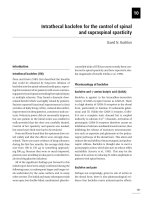Lecture Math for the pharmacy technician Concepts and calculations Chapter 10 – Lynn M. Egler, Kathryn A. Booth
Bạn đang xem bản rút gọn của tài liệu. Xem và tải ngay bản đầy đủ của tài liệu tại đây (1.58 MB, 46 trang )
Math for the Pharmacy Technician:
Concepts and Calculations
Egler • Booth
Chapter 10: Pediatric and
Geriatric Considerations
McGraw-Hill
©2010 by the McGraw-Hill Companies, Inc All Rights Reserved
Pediatric and Geriatric
Considerations
McGraw-Hill
©2010 by the McGraw-Hill Companies, Inc All Rights Reserved
10-3
Learning Objectives
When you have successfully completed Chapter 10, you
will have mastered skills to be able to:
Explain why dosages calculations for
specific populations must be based on the
individual patient.
Identify factors that affect the
absorption, distribution,
biotransformation, and elimination of
drugs in special populations.
Determine safe doses for special
population patients.
McGraw-Hill
©2010 by the McGraw-Hill Companies, Inc All Rights Reserved
10-4
Learning Objectives
(con’t)
Determine safe doses for special
populations.
Calculate patient dosages based on
body weight.
Calculate pediatric dosages using
Clark’s Rule.
Calculate pediatric dosages using
Young’s Rule.
McGraw-Hill
©2010 by the McGraw-Hill Companies, Inc All Rights Reserved
10-5
Learning Objectives
(con’t)
Find a patient’s body surface area
(BSA).
Calculate patient dosages based on a
patient’s BSA.
McGraw-Hill
©2010 by the McGraw-Hill Companies, Inc All Rights Reserved
10-6
Introduction
Two special populations require extra
consideration when calculating
medication dosages
Pediatric (children under age 18)
Geriatric (mature adults over age 65)
Risk of harm is far greater due to
way they break down and absorb
medications
McGraw-Hill
©2010 by the McGraw-Hill Companies, Inc All Rights Reserved
10-7
Introduction
(con’t)
Clarify all confusing drug orders
Calculate with absolute accuracy
Verify that dose is safe
Seek assistance from your
supervisor
Do not take short cuts with
medication calculations
McGraw-Hill
©2010 by the McGraw-Hill Companies, Inc All Rights Reserved
10-8
Factors that Impact Dosing
Normal dose of medication makes
assumptions
About the patient’s body and age
That body systems are fully developed
and functioning
Special populations may need
dosages adjusted due to this
assumption not being true
McGraw-Hill
©2010 by the McGraw-Hill Companies, Inc All Rights Reserved
10-9
Pharmacokinetics
Study of how drugs are used by the
body
Absorption
Distribution
Biotransformation
Elimination
Understanding these processes allows
for adjustments for special
populations
McGraw-Hill
©2010 by the McGraw-Hill Companies, Inc All Rights Reserved
10-10
Absorption
Process that moves a drug from the
site where it is given into the
bloodstream
IV medications bypass the absorption
process by going directly into the
bloodstream
Oral medications absorbed in digestive
system
Topical absorbed through the skin
McGraw-Hill
©2010 by the McGraw-Hill Companies, Inc All Rights Reserved
10-11
Distribution
Process that moves the drug from
the bloodstream to other body
tissues and fluids
Target site is where the drug
product produces its desired effect
Each drug affects drug target sites
McGraw-Hill
©2010 by the McGraw-Hill Companies, Inc All Rights Reserved
10-12
Biotransformation
Process that chemically changes the
drug in the body
Occurs primarily in the liver
Helps to protect the body from
foreign chemicals including drugs
McGraw-Hill
©2010 by the McGraw-Hill Companies, Inc All Rights Reserved
10-13
Elimination
Process where the drug leaves the
body
Main way of eliminating is in the
urine
Other ways
Air that we exhale
Sweat
Feces
Breast milk
Other body secretions
McGraw-Hill
©2010 by the McGraw-Hill Companies, Inc All Rights Reserved
10-14
Drug Adjustment
Adjustment is needed if one of these four
processes are not functioning within
certain limits.
Dose adjustment is made according to
nature and severity of patient’s condition.
You are not expected to make these
adjustments, but be aware that they may
have to be done.
McGraw-Hill
©2010 by the McGraw-Hill Companies, Inc All Rights Reserved
Conditions That Impact
Dosing
10-15
Functions of body systems change over
the life of a person
Newborns – systems not developed yet
pH of stomach is lower
Thinner skin
Liver still developing
Less circulation to muscles
McGraw-Hill
©2010 by the McGraw-Hill Companies, Inc All Rights Reserved
10-16
Conditions That Impact Dosing
(con’t)
Geriatrics – systems begin to
deteriorate
Skin and veins become fragile
Decreased liver function
Decreased kidney function
Poor circulation
McGraw-Hill
©2010 by the McGraw-Hill Companies, Inc All Rights Reserved
Working with Special
Populations
10-17
Other Considerations
Parent or caretaker may be
administering or assisting them
with medications
These individuals will need
education regarding any regular
or special requirements
McGraw-Hill
©2010 by the McGraw-Hill Companies, Inc All Rights Reserved
10-18
Teaching Patients or
Caretaker About Medications
1.
2.
3.
4.
5.
6.
Name of the medication
Purpose
How to store it
How long patient needs to take the
medication
How and when to take it
How to know if it is effective
McGraw-Hill
©2010 by the McGraw-Hill Companies, Inc All Rights Reserved
10-19
Teaching Patients or Caretaker
About Medications (con’t)
Required follow-up tests, doctor
appointments
8. Possible side effects and what to do
9. Interactions with other drugs and
foods
10. Symptoms to report to the doctor
11. What to do if a dose is missed
12. Keeping a list of all medications
7.
McGraw-Hill
©2010 by the McGraw-Hill Companies, Inc All Rights Reserved
10-20
Ensuring Safe Dosages
When you are working with special
populations, always check the package
insert, drug label, or product literature to
ensure the safety of the dose to be
administered.
Drug orders may be written in several
ways. If you measure the medication, you
have the responsibility to check whether
the dose is the standard recommended
dose.
McGraw-Hill
©2010 by the McGraw-Hill Companies, Inc All Rights Reserved
10-21
Ensuring Safe Dosages (cont.)
The recommended dose is sometimes
written as a range, with a minimum
and a maximum recommended dose.
In this case, you will need to
determine if the dose ordered is not
less than the minimum or greater
than the maximum recommended
dose.
McGraw-Hill
©2010 by the McGraw-Hill Companies, Inc All Rights Reserved
10-22
Review and Practice
Ensuring Safe Dosages
(con’t)
Determine whether the following order is
safe. If safe, calculate the amount to
administer.
Patient: Child who weighs 14.5 kg
Ordered: Amoxil 75 mg PO q8h
On hand: Usual child dose 20-40 mg/kg
day q8h
Answer: Dosage doesn’t fall within recommended
dosage range; contact the physician.
McGraw-Hill
©2010 by the McGraw-Hill Companies, Inc All Rights Reserved
10-23
CAUTION !
Convert ounces carefully.
The weight of babies is often measured in
pounds and ounces.
Because 16 oz = 1 lb, an ounce is not a
tenth of a pound.
A baby who weighs 8 lb 6 oz does not
weigh 8.6 lb.
McGraw-Hill
©2010 by the McGraw-Hill Companies, Inc All Rights Reserved
10-24
CAUTION! (con’t)
Convert 6 ounces
to pounds using
1 lb
16 oz as the
conversion
6 oz × 1 lb = 0.375 lb
16 oz
Thus, 8 lb 6 oz = 8.375 lb
McGraw-Hill
©2010 by the McGraw-Hill Companies, Inc All Rights Reserved
Dosages Based on Body
Weight
10-25
Calculating dosage based on body weight:
1.
Convert the patient’s weight to kilograms
2.
Calculate the desired dose, D, by
multiplying dose ordered by the weight in
kilograms such as
mg
mcg
x kg = desired dose or
x kg = desired dose
kg
kg
McGraw-Hill
©2010 by the McGraw-Hill Companies, Inc All Rights Reserved









